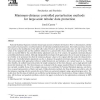Free Online Productivity Tools
i2Speak
i2Symbol
i2OCR
iTex2Img
iWeb2Print
iWeb2Shot
i2Type
iPdf2Split
iPdf2Merge
i2Bopomofo
i2Arabic
i2Style
i2Image
i2PDF
iLatex2Rtf
Sci2ools
EOR
2006
2006
Minimum-distance controlled perturbation methods for large-scale tabular data protection
National Statistical Agencies routinely release large amounts of tabular information. Prior to dissemination, tabular data needs to be processed to avoid the disclosure of individual confidential information. One widely used class of methods is based on the modification of the table cells values. However, previous approaches were not able to preserve the values of the marginal cells and the additivity relations for a general table of any dimension, size and structure. This void was recently filled by the controlled tabular adjustment and one of its variants, the quadratic minimum-distance controlled perturbation method. Although independently developed, both approaches rely on the same strategy: given a set of tables to be protected, they find the minimum-distance values to the original cells that make the released information safe. Controlled tabular adjustment uses the L1 distance; the quadratic minimum-distance variant considers L2.
| Added | 12 Dec 2010 |
| Updated | 12 Dec 2010 |
| Type | Journal |
| Year | 2006 |
| Where | EOR |
| Authors | Jordi Castro |
Comments (0)

